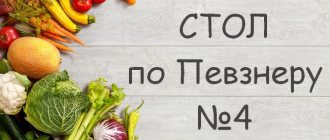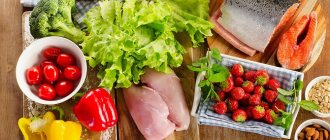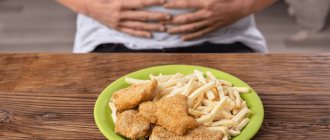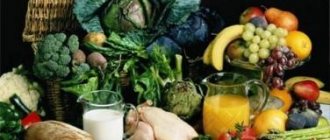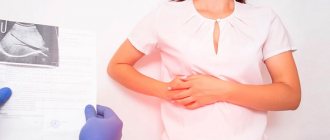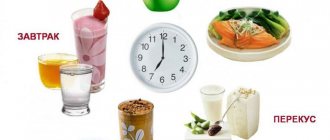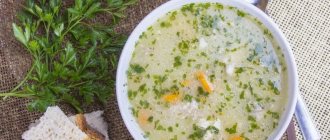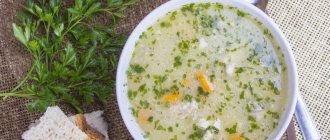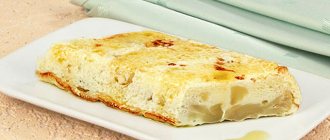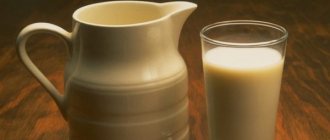Probably only small children do not know that the intestines belong to the organs of the gastrointestinal tract. The intestines play a very important role in our body – they help digest food. The entry of viruses and bacteria into the intestines leads to the development of inflammation and disruption of the mucous membrane. The inflammatory process can lead to undesirable consequences and many diseases of the gastrointestinal tract. During treatment of intestinal inflammation, you must adhere to a diet.
Why does inflammation occur?
Inflammation of the intestines is the result of poor nutrition
There are many causes of inflammation, but some of them occupy the main place. Therefore, doctors divided them into groups:
- inflammation is caused by various bacteria and viruses;
- worms that parasitize the intestines;
- occurs through the immunity of the immune system of mucosal cells. The fact is that sometimes the immune system perceives mucosal cells as foreign bodies, producing antibodies against them that cause inflammation;
- diseases can be hereditary or congenital;
- Inflammation occurs through diet abuse and overeating. People who often consume fatty and fried foods and hot spices are subject to inflammatory processes in the intestines, while the small intestine and duodenum suffer;
- the disease occurs through insufficient blood circulation in the intestines;
- inflammation develops when the microflora is disturbed.
When inflammation develops in the intestines, the cells of the mucous membrane begin to die, the blood supply to the organ increases, the absorption of nutrients stops, and a feeling of severe pain in the abdomen occurs. Inflammation can develop in different parts of the intestine:
- duodenum;
- small intestine;
- large intestine.
The disease can have an acute and chronic course. Inflammatory processes differ in their duration. If the acute form is characterized by the development of the disease within a month, then the chronic form lasts six months or more. In addition, a distinction is made between infectious and non-infectious intestinal diseases.
Page 2 of 12
Diet therapy for varying levels of inflammatory bowel disease
If the disease activity is high (frequent stools with a significant admixture of blood, abdominal pain, fever, joint pain, etc.), it is necessary to limit or completely eliminate regular food and replace it with artificial nutrition. Artificial nutrition is divided into enteral (in which nutritional mixtures enter the body through the mouth or tube) and parenteral (in this case, nutritional mixtures are administered intravenously).
Currently, the following types of enteral mixtures are distinguished: standard, semi-element mixtures, modular, targeted mixtures.
Standard mixtures contain all the necessary macro- and micronutrients in accordance with the daily needs of the body. They are used in most clinical situations when there are indications for enteral nutrition, with the exception of severe disorders of digestion and absorption of nutrients, as well as organ pathology (liver, kidney, etc.). Such mixtures include “Nutricomp standard liquid”, “Nutrizon standard”, “Clinutren optimum”, “Fresubin original” and a number of others.
Semi-element mixtures also include fully balanced nutrients, in which proteins are presented in the form of split molecules (peptides and amino acids). They are prescribed for severe disorders of the digestive and absorption functions, including in the early postoperative period (Peptamen, Nutrien Elemental).
Modular mixtures contain only one of the nutrients (protein, fat) or individual amino acids (glutamine), metabolic regulators (L-carnitine). They are used to supplement the diet of artificial or conventional medical nutrition.
Directional mixtures are created to correct metabolic disorders typical for this pathology (hepatic - Nutricomp Hepa Liquid, renal - Nutricomp Renal, immunity disorders (Impact Enteral, Nutricomp Immune Liquid, Nutrien Immun), diabetes mellitus – “Nutricomp Diabetes Liquid”, “Diazon”).
Methods of introducing enteral mixtures into the body: through a tube (carried out by medical personnel) or through the mouth (by the patient himself). For better absorption of mixtures and prevention of adverse events, it is better to administer the volume of mixture recommended by the doctor in small portions throughout the day. In this case, drip administration of mixtures through a tube can be used for tube feeding. If the patient is able to eat on his own, the “sipping” mode is recommended (drinking through a cocktail straw or in small sips).
Parenteral nutrition can be complete or partial. Total parenteral nutrition is carried out with fully balanced mixtures, including proteins, fats and carbohydrates, as well as vitamins and microelements necessary to maintain the vital functions of the body. Partial parenteral nutrition is provided by the administration of one or two essential nutrients (eg, proteins and carbohydrates).
In the case of intravenous administration of nutritional mixtures, the gastrointestinal tract is excluded from the digestion process. This type of nutrition has both its advantages (lack of irritating effects on the intestines, i.e. sparing it) and disadvantages (long-term shutdown of the gastrointestinal tract). The importance of the latter can be reduced if the duration of intravenous administration does not exceed 7-10 days and even before the end of parenteral nutrition, enteral mixtures are started.
As the activity of inflammation subsides, natural food dishes can be prescribed together with enteral mixtures. Adding dry protein composite mixtures (“DISO” Nutrinor”, “DISO” Nutrifib” and others) to dishes helps to increase the nutritional value of the natural diet (see below)
General characteristics of the diet in the phase of severe exacerbation of the disease. The content of fats and carbohydrates is limited; protein content is normal or slightly increased. A diet with a reduced content of table salt, with a sharp limitation of mechanical and chemical irritants of the mucous membrane of the gastrointestinal tract. Avoid foods and dishes that enhance the processes of fermentation and putrefaction in the intestines; in particular, milk, coarse fiber, spices and all dishes that stimulate bile secretion, gastric and pancreatic secretion. The diet is fractional - 5 - 6 times a day.
Chemical composition and energy value of the diet. Proteins - 70-85 g (of which 40-45 g are animal), fats - 70-80 g (of which 10 g are vegetable), carbohydrates - 250-300 g (of which 50 g are simple). Energy value – 1900-2200 kcal. Table salt – 6 g. Free liquid – 1.5-2 l.
Culinary processing. All dishes are pureed and cooked boiled or steamed. The temperature of hot dishes is 55-600 C, cold - not lower than 150 C.
Recommended products and dishes:
- bread and bakery products - crackers from white wheat bread, not toasted, thinly sliced;
- soups - in vegetarian, low-fat meat or fish broth with the addition of mucous infusions (rice, buckwheat, oatmeal, wheat flour), steamed or boiled meat or fish dumplings, meatballs, egg flakes, boiled and pureed meat, which is added together with mucous decoctions;
- meat and fish dishes - low-fat and lean varieties (beef, veal, poultry) in the form of steam cutlets, dumplings, meatballs, boiled meat soufflé - minced meat is passed 3-4 times through a meat grinder with a fine grid. Only fresh (not frozen) and low-fat varieties of fish (pike perch, bream, carp, cod, navaga, etc.) are allowed. The technology for preparing fish dishes is the same as for meat dishes;
- eggs and egg products - eggs (no more than 1 egg per day) are added to dishes;
- milk and dairy products - fresh cottage cheese (preferably precipitated with calcium salts - calcined) in pureed form. Whole milk – according to tolerance;
- vegetables and herbs are excluded;
- fruits, berries, sweets are excluded;
- cereals and pasta - pureed porridges made from rice, oatmeal, buckwheat, semolina and other cereals are prepared in water or in low-fat meat broth. Legumes are excluded;
- fats - fresh butter is added to dishes;
- snacks - excluded;
— sauces and spices are excluded;
- drinks and juices - weak tea, juices in the form of jelly, fruit and berry jelly, decoction of dried black currants, blueberries, bird cherry.
Prohibited: fresh bread, vegetables, herbs, legumes, fruits, berries in their natural form, mushrooms, whole milk, sauces, spices, snacks, eggs in their natural form, sweets, confectionery, honey, jam, carbonated drinks, cold dishes.
Table 1. Approximate one-day diet menu for severe exacerbation of inflammatory diseases, accompanied by diarrhea
| 1st breakfast: steamed protein omelette, semolina porridge with water, tea |
| 2nd breakfast: calcined cottage cheese (100g) |
| Lunch: pureed meat soup, steamed meatballs, blueberry jelly |
| Afternoon snack: rosehip decoction (1 glass) |
| Dinner: fish soufflé or boiled fish, boiled vermicelli, tea |
| At night: kefir (1 glass) |
| For the whole day: bread (crackers) – 200 g, sugar – 30 g, butter – 10 g. |
This diet option is physiologically inferior and monotonous. That is why, in the phase of severe exacerbation of the disease, it is better to prescribe it only as an addition to standard enteral mixtures in the form of separate dishes for 5-7 days
In the phase of subsiding exacerbation, they switch to a physiologically complete diet with a normal content of proteins and fats, a decrease in carbohydrates with a moderate limitation of table salt, mechanical and chemical irritants of the intestinal mucosa. Avoid foods and dishes that enhance the processes of fermentation and putrefaction in the intestines, as well as active stimulants of gastric secretion. The diet is split - 5-6 times a day.
Culinary processing. Dishes are pureed, cooked boiled or steamed. Soups are pureed or with finely chopped vegetables and well-cooked cereals. Individual dishes can be baked, but without a rough crust. The temperature of hot dishes is 55-600 C, cold - not lower than 150 C.
Chemical composition and energy value. Proteins 70-85 g (of which 45-50 g are animal), fats - 80-100 g (of which 10-15 g are vegetable), carbohydrates - 350-450 g (of which 50-60 g are simple). Energy value – 2400-2900 kcal. Table salt – 6 g.
Recommended products and dishes:
— bread and bakery products — day-old wheat bread, dry biscuit, dry “Maria” type cookies (total bakery products no more than 200 g per day);
- soups - prepared in water, weak low-fat meat or fish broth with well-cooked cereals, noodles, finely chopped vegetables (with the exception of white cabbage);
- meat and fish dishes - from lean meat and fish (non-old and lean beef, veal, chicken, turkey, rabbit, pike perch, pike, navaga cod) cutlets, meatballs, dumplings, soufflés, rolls are prepared in boiled or steamed form form;
- eggs and egg products - soft-boiled eggs (1 piece per day) or as additives to dishes; egg white omelettes, meringues, snowballs;
- milk and dairy products - milk only in limited quantities in dishes, fermented milk drinks - kefir, acidophilus, acidophilus milk, fermented baked milk, yogurt, etc. Freshly prepared cottage cheese (preferably calcined), natural, in the form of curd mass, curd steam puddings;
- vegetables and herbs - zucchini, pumpkin, carrots, green peas and a limited amount of potatoes are cooked boiled and pureed; a steamed vegetable soufflé from pureed vegetables is used. Ripe tomatoes in their natural form - no more than 100-150 g per day;
- fruits, berries, sweets - sweet varieties of berries and fruits (except melons, watermelons, apricots and plums) in the form of pureed compotes, jelly, jellies, mousses and various juices; baked apples, pears, preserves and jams from sweet varieties of berries and fruits; if well tolerated, strawberries, sweet ripe apples and pears can be consumed raw in limited quantities (up to 150 g);
- cereals and pasta - rice, buckwheat, oatmeal, rolled oats, semolina and other cereals in pureed form as side dishes, porridges, casseroles (without crust); vermicelli, noodles, small pasta - in soups, as side dishes and casseroles. It is advisable to add dry composite protein mixtures (for example, “DISO” Nutrinor”) to porridges in the amount of 2 tablespoons in order to increase the protein content in dishes;
- fats - unsalted butter is added to prepared dishes and to the table, but not more than 10 g per meal;
— snacks — mild cheese, Russian, Yaroslavl, etc.; doctor's sausage, pate sausage, veal sausage, soaked herring, jellied meat, jellied tongue;
- sauces and spices - sauces based on weak meat, vegetable and fish broths with dill, parsley leaves, milk bechamel sauce with the addition of a small amount of sour cream, fruit sauces; cinnamon can be used;
- drinks and juices - tea with milk, rosehip infusion, weak black coffee with milk; fruit and berry sweet juices, vegetable juices (not canned) half and half with water.
Prohibited: black bread, baked goods and pastry products; white cabbage, cucumbers, peas, beans, lentils, canned meat, fish, vegetables; fatty meats and fish; fried foods; strong coffee, whole vegetable juices; carbonated and cold drinks; ice cream, whole milk, cream, sour cream in natural form; chocolate and chocolate candies.
Table 2. Approximate one-day diet menu for patients with inflammatory bowel diseases in the phase of subsiding exacerbation
| 1st breakfast: boiled fish, mashed potatoes, pureed rice porridge with the addition of “DISO” Nutrinor mixture, tea |
| 2nd breakfast: calcined cottage cheese (100 g) |
| Lunch: mild grated cheese (30 g), pearl barley soup in meat broth with pureed carrots, meatloaf with pureed buckwheat porridge, apple jelly |
| Afternoon snack: rosehip decoction (1/2 cup), white omelette |
| Dinner: boiled tongue with carrot puree, calcined cottage cheese |
| At night: kefir (1 glass) |
| For the whole day: white bread – 300 g, sugar – 50 g, butter – 10 g, fruits, berries – 300 g |
For inflammatory bowel diseases, during the recovery period, the same diet is prescribed, expanding the diet by eating the same dishes, but not pureed, which allows you to restore the impaired functions of the digestive organs.
General characteristics. The diet is physiologically complete, with a normal content of proteins, fats, carbohydrates and a limitation of table salt, with some limitation of mechanical and chemical irritants of the mucous membrane of the gastrointestinal tract, with the exception of foods and dishes that enhance the processes of fermentation and putrefaction in the intestines, as well as strong stimulants of bile secretion , secretions of the stomach and pancreas, substances that irritate the liver. The diet is split - 5-6 times a day.
Culinary processing. Food is prepared boiled, steamed, and also baked in the oven, and served mostly unchopped. The temperature of hot dishes is 55-60 0 C, cold dishes - not lower than 150 C.
Chemical composition and energy value. Proteins – 75-85 g (including animal 40-50 g), fats – 80-110 g (including vegetable 15-20 g), carbohydrates – 350-450 g (including simple 40-60 g) . Energy value – 2400-2900 kcal. The amount of free liquid is 1.5 l. Table salt – 6 g.
Recommended products and dishes:
- bread and bakery products - day-old wheat bread, dry sponge cake, dry cookies like “Maria” 1-2 times a week, no more than 2-4 buns, well baked, but without adding butter to the dough. Pie with boiled meat and eggs, apples or cheesecake with cottage cheese.
- soups - with water, weak low-fat meat or fish broth with various cereals (except millet), noodles, vegetables (potatoes, carrots, zucchini, pumpkin, cauliflower). If tolerated well, white cabbage, green peas, young beans, and beets are allowed;
- meat and fish dishes - lean and lean meat (beef, rabbit, turkey, chicken), tongue, lean ham, diet sausages, lean fish (pike perch, pike, bream, navaga, cod, carp). Meat and fish, pureed and minced, boiled, stewed, steamed, baked 2 times a week, in pieces;
- eggs and egg products - whole eggs (no more than 1 piece per day) in dishes, protein steamed omelettes, meringues, snowballs. If well tolerated, use whole soft-boiled eggs, steam omelets made from whole eggs;
- milk and dairy products - milk in dishes, if well tolerated, can be consumed in its pure form; fermented milk drinks - kefir, yogurt, acidophilus, acidophilus milk, fermented baked milk, etc. (if well tolerated); fresh, natural cottage cheese, in the form of curd paste, steamed and baked puddings;
- vegetables and greens - potatoes (in limited quantities), carrots, beets, pumpkin, zucchini, cauliflower, boiled, baked, steamed, ungrated and pureed; lettuce and parsley leaves, fresh tomatoes in the form of salad; finely chopped young greens as an addition to dishes. Turnips, cucumbers, radishes, radishes, sorrel, spinach, onions, garlic, mushrooms are excluded;
- fruits, berries, sweets - fresh ripe fruits and berries (except melons, apricots, watermelons and plums), raw, in their natural form, baked; dry fruits and berries; ripe varieties of apples and pears (no more than 200 g per day); if well tolerated - tangerines and oranges; marmalade, pastille, marshmallows, sugar;
- cereals and pasta - various crumbly porridges (except millet and pearl barley) in water, in meat broth, with the addition of milk or a third of 10% cream, steamed and baked puddings, cutlets (without breading), pilaf, zrazy, dumplings, pancakes ; boiled vermicelli, finely chopped pasta, milk noodles in the form of side dishes, casseroles, puddings. During preparation, dry protein composite mixtures (“DISO” Nutrinor”) are added to porridges;
- fats - butter (do not fry) is added to prepared dishes, given in its natural form to the table, no more than 10 g per serving;
— appetizers — jellied fish, tongue, veal, mild cheese, black caviar, doctor’s sausage, soaked herring, lean ham;
— sauces and spices — sauces based on vegetable broth, meat broth using bay leaves, dill, parsley leaves, cinnamon; milk bechamel sauce with the addition of a small amount of sour cream; fruit sauces;
- drinks and juices - rosehip decoction, natural tea with milk or cream, coffee with milk or cream and weak black coffee, fruit juices (except grape), berry juices; vegetable juices (except cabbage), diluted 1/3 with water.
Prohibited: black bread; millet, pearl barley; white cabbage, beans, peas, lentils, mushrooms, fatty meats and fish, fried foods; cucumbers, turnips, radishes, radishes, sorrel, spinach, onions, garlic; fresh melons, apricots, watermelons, plums; grape juice; undiluted vegetable juices; cabbage juice; canned meat, fish, and vegetables; chocolate, cocoa, honey.
If tolerated well, it is allowed to add white cabbage, green peas, young beans, beets to soups; whole milk, young finely chopped greens, tangerines and oranges, marmalade, marshmallows, and marshmallows are introduced into the diet.
Table 3. Sample menu of diet options for patients with inflammatory bowel diseases in remission
| 1st breakfast: rice milk porridge with the addition of “DISO Nutrinor” mixture, steamed protein omelette (from 2 eggs), tea with milk |
| 2nd breakfast: calcined cottage cheese (150 g) |
| Lunch: meat broth soup with cauliflower, boiled meat with boiled rice, fresh apples |
| Afternoon snack: boiled meat, rosehip decoction (200 g) |
| Dinner: baked curd pudding, steamed meatloaf with stewed carrots and green peas, tea with milk, fresh fruits (or berries) |
| At night: kefir (1 glass) |
| For the whole day: white bread – 300 g, sugar – 40 g, butter – 10 g |
If the patient maintains stable remission, significant restrictions on certain products are not required. In addition to boiling, culinary processing also includes baking and even frying. During this period, it is recommended to eat the most natural and fresh foods possible. Despite the ongoing remission, it is advisable to exclude seeds, nuts, mushrooms, vinegar and a number of other foods that are traumatic and irritating to the intestines from the diet.
- Back
- Forward
How to find out about the development of inflammation in the intestines?
Diet as a method of treating intestinal inflammation
Before treating the intestines in all possible and impossible ways, you need to make sure that inflammation is developing in it. This disease is characterized by some symptoms that distinguish it from other similar intestinal infections. Regardless of the location of the inflammatory process, the patient feels abdominal pain. In this case, the pain is not localized in one specific place, but has a bursting character. The disease is also characterized by a feeling of nausea after each meal. Rather, this symptom indicates that inflammation has affected the small intestine or duodenum.
After the stomach has emptied, relief comes. As inflammation of the small intestine develops, a deficiency of digestive enzymes occurs. In this case, the patient's abdomen becomes bloated due to increased gas formation. With inflammation, the patient develops diarrhea due to an acute intestinal infection. When, on the contrary, the patient experiences constipation, it means that inflammation develops in the large intestine. When a patient suddenly loses weight without dieting, it means that the inflammation is localized in the small intestine. Often patients with the disease suffer from anemia. This is the result of low hemoglobin, due to a lack of iron in the body.
The urge to vomit indicates inflammation of the upper organ. It usually occurs when the patient eats a tasty meal.
Authorized Products
The diet menu for colitis should include foods that ensure normal digestion, delay bowel movements, and allow the intestines to quickly absorb them.
These include bakery and dairy products with low acidity, and “strengthening” products (coffee, cocoa), as well as those containing large quantities of vitamins.
In addition, it is necessary to ensure mechanical and chemical sparing of the digestive tract, so all dishes should be pureed or finely chopped, and served warm.
The list of permitted products includes:
- white bread crackers, biscuits, biscuits;
- low-fat and diluted broths, soups with boiled cereals or chopped vegetables (potatoes, zucchini);
- lean varieties of meat and poultry and dishes made from them (steamed cutlets with rice, meatballs): veal, beef, rabbit, skinless chicken;
- low-fat fish, boiled or steamed, baked;
- boiled porridge in water (buckwheat, rice, oatmeal);
- eggs in the form of a white omelet or soft-boiled;
- vegetables: potatoes, zucchini, cauliflower, pumpkin, carrots in the form of puree, soufflé, casseroles or boiled;
- baked apples, in the form of puree, without peel and red, decoctions of barberry, black currant, quince; pears, bananas;
- small amount of butter;
- low-fat cottage cheese and low-acid sour cream;
- mild and unsalted cheeses;
- bay leaf, vanillin, cinnamon, a little dill and parsley;
- chocolate, strong tea, coffee, diluted juices (excluding apricot, grape and plum);
- marmalade, pastille;
- jelly, jelly.
Diagnostic methods
In order to make sure of an accurate diagnosis and prescribe the correct treatment, the doctor must conduct a complete diagnosis. He prescribes laboratory and instrumental examination methods to the patient. The patient should not self-medicate without making sure the diagnosis is correct. For inflammation, the following is prescribed:
- a blood test that can be used to determine the erythrocyte sedimentation rate and the number of leukocytes in the blood;
- stool examination in the laboratory will allow us to study the functioning of the intestines and the amount of digestive enzymes;
- stool examination using a bacteriological method will allow you to find out about the presence of bacteria, their type, sensitivity to drugs;
- endoscopic examination, which can be used to examine the mucous membrane. To study the inflammation in more detail, a biopsy can be performed by taking a piece of mucosal tissue;
- colonoscopy is used, when a special sensor is inserted through the anus to examine the large intestine and study the mucous membrane;
- It is effective to prescribe video capsule endoscopy, which allows for a detailed examination of the intestines. The patient is asked to swallow a special capsule that has a built-in camera and lighting. When the patient swallows such a capsule, it, in turn, will move throughout the intestines throughout the day. Information from the camera will be displayed on the computer screen using radio waves. As a result, the doctor will receive a complete picture of the condition of the mucous membrane of all parts of the organ.
Menu for constipation (Meal mode)
A proper nutrition menu should include 25-30 g of dietary fiber daily. Rye bran bread is allowed 150 g, and wheat bread 200 g, butter 10 g and sugar 40 g. Do not forget about taking water with honey, juice with pulp, dried fruit compote, prune infusion or rosehip decoction on an empty stomach. At night, eat prunes and kefir with the addition of 1 tbsp. l. bran When taking additional bran, do not forget to follow the drinking regime, otherwise they may have the opposite effect.
In case of chronic intestinal obstruction, nutrition is primarily aimed at regulating stool and unloading the intestines by eliminating hard-to-digest foods. The main requirement is to limit the amount of food you eat, avoiding overeating. Eat meals in small portions every 2 hours.
The second goal of the diet is to eliminate fermentation and putrefactive processes, so foods that cause gas formation (peas, raw white cabbage, legumes, whole milk, carbonated drinks) are excluded.
Moderate mechanical care is provided. Chemical irritants should be completely excluded (hot spices, hot seasonings). During the period of exacerbation, mechanical sparing should be maximum ( Diets No. 4 or No. 4B ). Fats and simple carbohydrates are limited. The norm of carbohydrates is 250 g (40-45 g are simple sugars), fats 60-70 g, protein 70-80 g (60% animal origin).
Vegetables and fruits should be consumed in moderation and boiled, since excess fiber can cause flatulence . The meat must be ground, you must include fermented milk products and follow the drinking regime. It is allowed to eat prunes, figs, dried apricots. Due to its high calcium content, cottage cheese can cause constipation, so it should be consumed with caution. Pasta is excluded, and from cereals - pearl barley, millet and barley.
| Breakfast |
|
| Lunch |
|
| Dinner |
|
| Dinner |
|
| For the night |
|
Effective treatments
Symptoms of intestinal inflammation - indigestion and upset
Treatment of the disease may vary. It all depends on the form of intestinal inflammation, the course and duration of the symptoms. Basically, doctors offer complex treatment, which includes etiotropic therapy, diet, pathogenetic and symptomatic therapy. These methods are aimed at eliminating the cause of the pathology, relieving inflammation, alleviating the patient’s condition and reducing the load on the intestines. Of course, you cannot do without taking medications, but in addition, it is important for the patient to maintain proper nutrition. A diet for inflammation will help to significantly reduce the load on the mucous membrane, which is affected by the inflammatory process.
Prohibited Products
The menu of the treatment table for colitis should not include those foods that cause fermentation and putrefaction in the intestines, stimulate gas formation and peristalsis.
These include both coarse plant fiber and legumes. In addition, it is not recommended to consume spices - they are irritating to the digestive tract.
Fats, especially of plant origin, are also limited, as they interfere with the absorption of nutrients in the intestines and speed up bowel movements, which is not good for diarrhea. The same applies to dairy products, especially if you are lactose intolerant.
Stimulators of bile secretion and the release of pancreatic enzymes, for example, extractives, increase the load on the liver and worsen the course of colitis.
List of foods prohibited for colitis
- brown bread, wholemeal or whole grain bread, baked goods;
- rich meat and fish broths;
- pasta, beans, peas, lentils, beans;
- fatty meats and poultry, especially fried foods;
- pickles, marinades, smoked meats;
- canned food, caviar;
- fatty fish;
- mushrooms in any form;
- raw vegetables;
- raw fruits and berries, dried fruits, honey, jam;
- dairy products, whole milk;
- coffee and cocoa with milk;
- nuts;
- fast food, chips, crackers;
- fried or hard-boiled eggs;
- spices (mustard, pepper, vinegar, garlic and others);
- cereals: pearl barley, barley, wheat, wheat, barley;
- fats other than butter.
